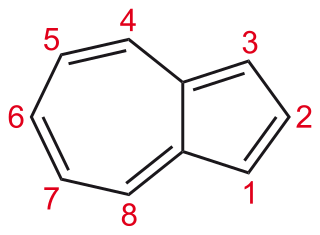In chemistry isomerization or isomerisation is the process in which a molecule, ion or molecular fragment is transformed into an isomer with a different chemical structure. Enolization is an example of isomerization, as is tautomerization. When the isomerization occurs intramolecularly it may be called a rearrangement reaction.

Azulene is an organic compound and an isomer of naphthalene. Whereas naphthalene is colourless, azulene is dark blue. Two terpenoids, vetivazulene (4,8-dimethyl-2-isopropylazulene) and guaiazulene (1,4-dimethyl-7-isopropylazulene), that feature the azulene skeleton are found in nature as constituents of pigments in mushrooms, guaiac wood oil, and some marine invertebrates.

An iminium cation in organic chemistry is a functional group with the general structure [R1R2C=NR3R4]+. They are common in synthetic chemistry and biology.

Guaiazulene, also azulon or 1,4-dimethyl-7-isopropylazulene, is a dark blue crystalline hydrocarbon. A derivative of azulene, guaiazulene is a bicyclic sesquiterpene that is a constituent of some essential oils, mainly oil of guaiac and chamomile oil, which also serve as its commercial sources. Various soft corals also contain guaiazulene as a principal pigment. Its low melting point makes guaiazulene difficult to handle, in contrast to the crystalline nature of the parent azulene. The electronic structure of guaiazulene and azulene are very similar.
Cycloheptatriene (CHT) is an organic compound with the formula C7H8. It is a closed ring of seven carbon atoms joined by three double bonds (as the name implies) and four single bonds. This colourless liquid has been of recurring theoretical interest in organic chemistry. It is a ligand in organometallic chemistry and a building block in organic synthesis. Cycloheptatriene is not aromatic, as reflected by the nonplanarity of the methylene bridge (-CH2-) with respect to the other atoms; however the related tropylium cation is.

Kasha's rule is a principle in the photochemistry of electronically excited molecules. The rule states that photon emission occurs in appreciable yield only from the lowest excited state of a given multiplicity. It is named for American spectroscopist Michael Kasha, who proposed it in 1950.

Fulvalene (bicyclopentadienylidene) is the member of the fulvalene family with the molecular formula C10H8. It is of theoretical interest as one of the simplest non-benzenoid conjugated hydrocarbons. Fulvalene is an unstable isomer of the more common benzenoid aromatic compounds naphthalene and azulene. Fulvalene consists of two 5-membered rings, each with two double bonds, joined by yet a fifth double bond. It has D2h symmetry.
The molecular formula C10H8 (molar mass: 128.17 g/mol) may refer to:
The Prix Cléopâtre is a Group 3 flat horse race in France open to three-year-old thoroughbred fillies. It is run over a distance of 2,100 metres at Saint-Cloud in May.
In organic chemistry, two molecules are valence isomers when they are constitutional isomers that can interconvert through pericyclic reactions.
In organic chemistry, benzenoids are a class of chemical compounds with at least one benzene ring. These compounds have increased stability from resonance in the benzene rings. Most aromatic hydrocarbons are benzenoid. Notable counterexamples are cyclooctadecanonaene, azulene and trans-bicalicene.

Chamazulene is an aromatic chemical compound with the molecular formula C14H16 found in a variety of plants including in chamomile (Matricaria chamomilla), wormwood (Artemisia absinthium), and yarrow (Achillea millefolium). It is a blue-violet derivative of azulene which is biosynthesized from the sesquiterpene matricin.

Werner Tochtermann was a German chemist and emeritus professor. From 1976 till his retirement in 1999 he was full professor of Organic Chemistry at the University of Kiel. His main areas of research were the chemistry of medium and large rings, the synthesis of cyclophanes, and the heteroquadricyclane→heteropin rearrangement, e.g. for the synthesis of oxepins from furans.
The molecular formula C15H20O2 (molar mass: 232.32 g/mol) may refer to:
The Buchner ring expansion is a two-step organic C-C bond forming reaction used to access 7-membered rings. The first step involves formation of a carbene from ethyl diazoacetate, which cyclopropanates an aromatic ring. The ring expansion occurs in the second step, with an electrocyclic reaction opening the cyclopropane ring to form the 7-membered ring.

Nuru is Japanese erotic massage technique from Kawasaki, Japan. The technique requires one or more nuru masseuses to rub their body against the client's body when both parties are nude and covered with an odorless and colorless massage lotion. The massage gel is slippery, organic, made from nori seaweed and different types are available.

Thermal rearrangements of aromatic hydrocarbons are considered to be unimolecular reactions that directly involve the atoms of an aromatic ring structure and require no other reagent than heat. These reactions can be categorized in two major types: one that involves a complete and permanent skeletal reorganization (isomerization), and one in which the atoms are scrambled but no net change in the aromatic ring occurs (automerization). The general reaction schemes of the two types are illustrated in Figure 1.

Spathulenol is a tricyclic sesquiterpene alcohol which has a basic skeleton similar to the azulenes. It occurs in oregano among other plants.

Elassovalene (2a,8b-dihydro-cyclopent[cd]azulene) is a polycyclic hydrocarbon with chemical formula C12H10, composed of one cycloheptatriene ring and two fused cyclopentene rings.

Matricin is a sesquiterpene. It can be extracted from flower of chamomille. Matricin is colorless.












